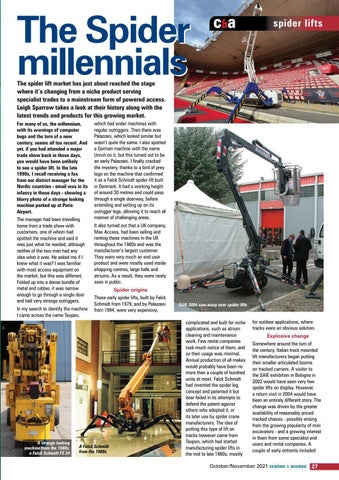The Spider millennials
c&a
spider lifts
The spider lift market has just about reached the stage where it’s changing from a niche product serving specialist trades to a mainstream form of powered access. Leigh Sparrow takes a look at their history along with the latest trends and products for this growing market.
For many of us, the millennium, with its warnings of computer bugs and the turn of a new century, seems all too recent. And yet, if you had attended a major trade show back in those days, you would have been unlikely to see a spider lift. In the late 1990s, I recall receiving a fax from our district manager for the Nordic countries - email was in its infancy in those days - showing a blurry photo of a strange looking machine parked up at Paris Airport. The manager had been travelling home from a trade show with customers, one of whom had spotted the machine and said it was just what he needed, although neither of the two men had any idea what it was. He asked me if I knew what it was? I was familiar with most access equipment on the market, but this was different. Folded up into a dense bundle of metal and rubber, it was narrow enough to go through a single door and had very strange outriggers. In my search to identify the machine I came across the name Teupen,
A strange looking machine from the 1980s, a Falck Schmidt FS 24
which had wider machines with regular outriggers. Then there was Palazzani, which looked similar but wasn’t quite the same. I also spotted a German machine with the name Unruh on it, but this turned out to be an early Palazzani. I finally cracked the mystery, thanks to a bird of prey logo on the machine that confirmed it as a Falck Schmidt spider lift built in Denmark. It had a working height of around 30 metres and could pass through a single doorway, before extending and setting up on its outrigger legs, allowing it to reach all manner of challenging areas. It also turned out that a UK company, Max Access, had been selling and renting these machines in the UK throughout the 1980s and was the manufacturer’s largest customer. They were very much an end user product and were mostly used inside shopping centres, large halls and atriums. As a result, they were rarely seen in public. Spider origins Those early spider lifts, built by Falck Schmidt from 1979, and by Palazzani from 1994, were very expensive,
A Falck Schmidt from the 1980s
SAIE 2004 saw many new spider lifts
complicated and built for niche applications, such as atrium cleaning and maintenance work. Few rental companies took much notice of them, and so their usage was minimal. Annual production of all makes would probably have been no more than a couple of hundred units at most. Falck Schmidt had invented the spider leg concept and patented it but later failed in its attempts to defend the patent against others who adopted it, or its later use by spider crane manufacturers. The idea of putting this type of lift on tracks however came from Teupen, which had started manufacturing spider lifts in the mid to late 1980s, mostly
for outdoor applications, where tracks were an obvious solution. Explosive change Somewhere around the turn of the century, Italian truck mounted lift manufacturers began putting their smaller articulated booms on tracked carriers. A visitor to the SAIE exhibition in Bologna in 2002 would have seen very few spider lifts on display. However, a return visit in 2004 would have been an entirely different story. The change was driven by the greater availability of reasonably priced tracked chassis - possibly arising from the growing popularity of mini excavators - and a growing interest in them from some specialist end users and rental companies. A couple of early entrants included
October/November 2021 cranes & access
27



















